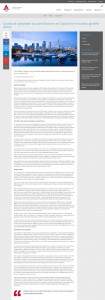by Jonathan Dodds, CEO Americas
The Canadian economy shows some signs of faltering, but White Clarke Group’s Jonathan Dodds still sees good potential for equipment financing.
Economic slowdown
When the world financial system collapsed in 2007, Canada recovered faster from recession than any of the other members of the G7. Its banks remained solid owing to the banking sector’s tradition of conservative lending practices and strong capitalization, and low interest rates encouraged consumer borrowing and spending. The government’s policies for dealing with the fiscal deficit were widely acknowledged as a model to follow.
But recently, along with many leading economies, Canada has stuttered. The economy is forecast to grow by a mere 1.6% in 2013. Exports have failed to meet projections, investment has stalled, and it is feared that government austerity measures are constraining growth. The only growth driver would seem to be continued consumer spending and borrowing built on very low interest rates (currently 3% (prime rate) and unlikely to change in the foreseeable future). The outgoing governor of the Bank of Canada, Mark Carney however has sounded the alarm on increasing and potentially unsustainable levels of consumer debt that are inflating a housing bubble in several cities.
Business investment is forecast to rise by only 1.7% this year. Canadian firms continue to stockpile cash rather than invest for growth (‘dead cash’, as Carney called it). Yet finance minister Jim Flaherty’s budget on 21 March was more focused on eliminating the federal budget deficit than on encouraging business investment or exports. However, the budget did extended the scheme allowing manufacturers to write off purchases of machinery and equipment faster, but this is likely to have limited impact until business confidence improves.
The effect of the economic situation on asset finance
In line with the slowing economy, the general consensus in the asset finance industry is one of caution, but underpinned by some optimism. As Bill Dost, President of D&D Leasing sees it: “The Canadian economy itself, which did not fall off the proverbial cliff like some of our western world counterparts, is getting set for a slow-down in the latter half of this year. This is a combination of business either not seeking financing, not getting financing, or simply wanting to wait it out. While the USA and the UK are pushing for growth and stimulus to drive equipment finance forward you are currently not seeing a great deal of initiatives on the Canadian front, and yet customers still need financing. Perhaps they need to be told it’s safe and smart to start buying again.”
Competing with low bank rates can make it more difficult for equipment leasing and financing businesses to maintain margins – they have to manage a slightly higher risk profile in order to achieve better margins. However, current feeling is that Canadian firms are decently priced and you do not see rampant low margins sometimes seen in other countries. But for bigger deals, naturally the banks will always attempt to out-compete the lessor.
The strength of the Canadian dollar relative to the US currency is negatively impacting Canadian exports to the US; but on the other hand, improved economic performance in the US will percolate north of the border, thus improving prospects for growth on the Canada equipment leasing industry.
Others feel that too much emphasis is placed on the macroeconomic factors. Moe Danis, Vice President, Lease Finance, at Pacific & Western Bank of Canada, suggests: “If companies could focus on their immediate surroundings and assess the prospects, the market would likely be far more robust.”
The asset finance sector itself is quite healthy. Leasing volume (new business) in 2012 was estimated to total C$37 billion, an increase of 16% over 2011; of this total, equipment and commercial vehicle leasing accounted for C$20 billion (up 23% on 2011 and represents a market penetration for leasing of 18%) and retail vehicle leasing accounted for C$17 billion (up 9% on 2011). (Source: CFLA)
Growth sectors
The asset finance and leasing industry is seen to be performing well under difficult economic pressures. The markets are being sustained by a number of factors, including pent-up demand from delayed purchases of equipment during the downturn, proven productivity gains from new product innovation, diversification of trading partners outside of the US for Canadian manufacturers, and Asian demand for commodities resulting in capital equipment purchases for Canadian suppliers.
The general consensus is that the equipment leasing and financing market in Canada will grow faster than GDP at around 2%, which would indicate short-term moderate growth at best as overall growth targets have been reduced.
Above-average performance should be expected from the commercial vehicle market, where there is some pent-up demand in the system. Other segments highlighted for above-average performance include agriculture, technology (including financing for cloud computing), construction equipment and most definitely resources, where the strong oil industry means growth for oil and gas servicing companies and miners. Companies that deal with Canada’s raw materials are doing very well currently and these are always great prospects for the equipment financing industry. Trucking and logistics are booming, especially in the owner/operator sector. Clean technology and healthcare also represent bright prospects for the future.
Asset finance is of vital importance to the small and medium-sized enterprise (SME) sector, but Canadian SMEs have a traditionally cautious approach to funding, which translates into a ‘wait and see’ approach towards decisions involving capital outlay for new equipment. However, there is considerable demand in the pipeline after a few soft years and with a strong Canadian dollar and very low interest rates, there is stimulus for a pick-up in equipment sales. This is positive for leasing companies in general, but pricing is very competitive, with more dollars chasing fewer deals.
Bill Dost concurs: “As for areas with the greatest potential, what we are seeing right now is the rise of the smaller business. The owner operator, 1-5 employee business understands the needs for growth and we are seeing an uptick in this realm of business in both the west and central parts of Canada.”
On the other hand, there is also the view that larger businesses are better positioned for recovery as they have the resources to make the necessary capital investments. Large business appears to be stronger, and positioned for recovery. Balance sheets are, in general, quite strong, with manageable debt levels, and resources are available to take advantage of the low rates and strong Canadian dollar. SMEs just do not have the wherewithal to withstand a misstep.
Consolidation and expansion
The demand for capital assets is still strong and leasing industry consolidation in recent years has provided opportunity for increased market share for participants who are willing to invest. The commercial equipment finance industry in Canada is progressing through a consolidation cycle, and there is ongoing potential for realignment in the lessor community. A number of large US players have pulled out, offering the potential for Canadian lessors, large and small, to step in and fill the void. Hugh Swandel, Senior Managing Director of The Alta Group in Canada and a Board Director at the CFLA, sees a reshaping of the market, both in types of players and business terms.
“Canadian banks were the main acquirers of independent firms, but other firms have also increased activity. Steve Hudson, who was the founder of Newcourt Credit Group, has taken an investment into a small independent firm, Element Financial, and turned it into a multi-billion dollar origination platform with a public market cap of $597 million. In addition to Canadian bank and Element acquisitions, GE, CIT, DLL and Wells Fargo are all pursuing growth in Canada.”
The changes in the market have increased competition, causing pricing to narrow and credit terms to soften. The number of independent companies has shrunk considerably and it is anticipated that independent activity will be limited to non-conventional credit markets where higher margins can be achieved. Although the number of commercial equipment firms operating in Canada has declined, the remaining players are all well capitalized and are generally becoming more aggressive with pricing and credit terms.
The major Canadian players have been purchased by banks over the last couple years; this could lend itself to some great plays by niche players in 2013 and 2014. Bill Dost says: “I believe you are starting to see this slowly, with some newer entrants that want to do things differently and existing smaller players that have decided to work harder for the business. There is great business out there to be bought; it has to be worked for, it has to be demonstrated that one deserves it, and I think people have to be reminded that it’s time to focus, or refocus as it were, on growth.”
International expansion is also on the cards, with future growth potential for big lessors going global, particularly for a vendor model shop. For companies that already have a global reach, there is still great opportunity; for example, partnership with vendors in evolving pockets of growth in emerging markets like China and India. However, there is still room for solid growth in established markets such as Canada, the US and Europe for financiers who demonstrate innovation and creativity resulting in enhanced value for customers.


